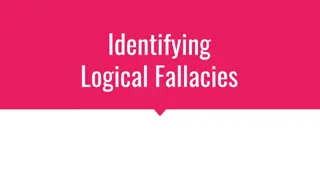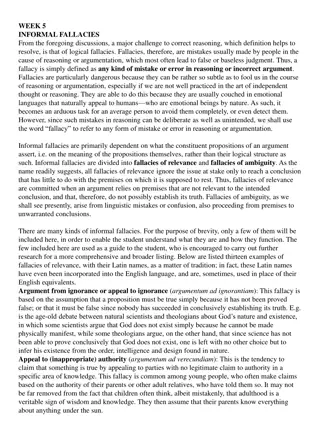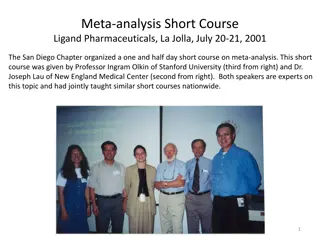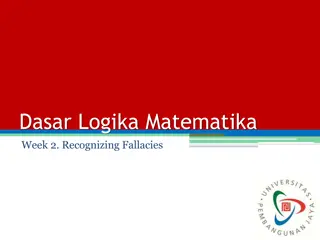Understanding and Avoiding Statistical Fallacies in Medical Literature
Statistical fallacies, which can significantly reduce the credibility of reports, are common in medical literature. These fallacies often arise from issues with sample problems, inadequate analysis techniques, errors in presentation of findings, and misinterpretation of statistical results. Maintaining objectivity in research, focusing on factual data, and avoiding personal biases are essential strategies to prevent fallacies. By following guidelines for developing objectivity in research, such as ensuring relevance, significance, and feasibility, researchers can enhance the validity of their conclusions and uphold the integrity of their work.
Download Presentation

Please find below an Image/Link to download the presentation.
The content on the website is provided AS IS for your information and personal use only. It may not be sold, licensed, or shared on other websites without obtaining consent from the author. Download presentation by click this link. If you encounter any issues during the download, it is possible that the publisher has removed the file from their server.
E N D
Presentation Transcript
Statistical Fallacies A fallacy is reasoning that is logically invalid, or that undermines the logical validity of an argument. All forms of human communication can contain fallacies.. Fallacies are anomalies that considerably reduce the credibility of a report. Statistical fallacies are common in medical literature
Why does Fallacies Occur? Some of the fallacies in medical literature may occur due to: Problems with the sample: The investigation should provide sufficient and valid data to take a decision. Sometimes this does not happen for various reasons. Inadequate analysis: Among the most common sources of fallacies in data- based conclusions is the use of inappropriate method of analysis. Errors in presentation of findings: Out of ignorance or deliberate, the presentation of data in medical reports sometimes lack propriety. This can happen in a variety of ways. Misinterpretation: Misinterpretation of statistical results is mostly due to failure to comprehend them in their totality and inability to juxtapose them with the realities of the situation. This can happen either because many medical professionals have limited knowledge of statistical concepts [8], or because of inadequate understanding of medical issues by the statisticians associated with medical projects.
Maintaining Objectivity Reiss and Sprenger (2014) provide strategies for maintaining objectivity in quantitative research which are explained below: Focus on the facts and data collected: your interpretation should be based on the factual data that you have collected. You should be able to prove your hypothesis or your claims through the factual evidence that you have collected. Ensure that the research is value free: as far as possible, your research should not reflect your own values alone. Our values influence the choice of the research design, the selection of the tools of measurement, the development of a hypothesis/research statement as well as the interpretation of the results. However, you can ensure that your values do not impinge on the design of the research and the interpretation of data by developing a stated value premise.
Developing objectivity in research Myrdal provides guidelines on how this could be developed. These include: Relevance: the value should be held by people or groups of people in society and should not be something that the researcher alone perceives as important Significance: a substantial number of people should view the value as being important; alternatively, a small but socially powerful group should consider the value as being one of great consequence. Feasible:- values that aim for perfection or unattainable goals should not be considered as a base for research Ensure that the research is free from personal biases Ensure that the instrument we use for our research is reliable and valid.
Reliability Reliability is concerned with consistency, accuracy and predictability of the scale. It refers to the extent to which a measurement process is free from random errors. The reliability of a scale is measured using the following methods: Test-retest reliability Split half reliability method
Validity Validity of a scale refers to the question whether we are measuring what we want to measure. Validity of the scale refers to the extent to which the measurement process is free from both the systematic and random error. Types of validity measure: Content Validity Concurrent Validity Predictive Validity























